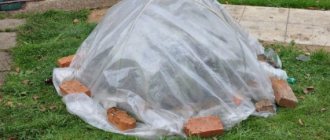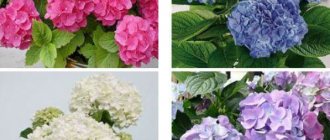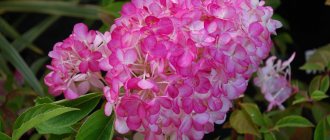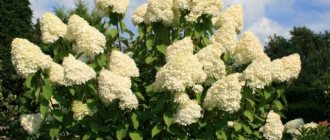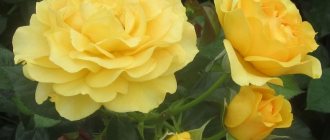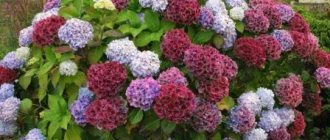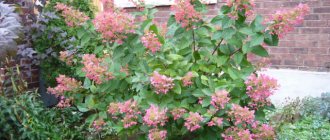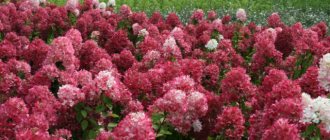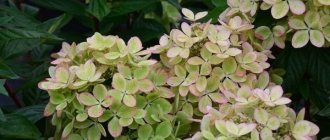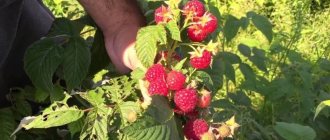Hydrangea Endless summer in landscape design
The very decent height of the large-leaved hydrangea bush allows it to be used as a decorative background for lower plants. The dense, dark green foliage of Endless Summer sets off the white and light flowers growing in the foreground. You should not plant large-leaved hydrangea along paths unless the goal is to create a green corridor.
Other types of hydrangeas can be cut at the root in winter and flowers can be produced on new shoots in the summer. Endless Summer" requires a different approach; it is unsuitable as a green border.
The Endless Summer bush will look good on the top of a decorative hill surrounded by shorter plants.
Comment! Large-leaved hydrangea has one more advantage: its flowers are easily air-dried and last a long time in this form.
Endless Summer grows well in containers. This allows plants to be used to decorate porches and courtyards.
Origin and appearance
According to popular belief, the Endless Summer hydrangea was bred in 2003 in Minnesota, USA. In fact, selection work began much earlier - at the end of the 20th century. It was then, in the winter of 1982, that breeders discovered a relationship between frost and the germination of some species.
Origin and appearance
Hydrangea Macrophylla is the official name of the big leaf hydrangea. The tall species can reach up to 2-3 m in height with a maximum crown width of 100 cm. The plant is characterized by dark green elliptical leaves with a jagged structure, which can grow up to 15 cm in length.
Despite the fact that the birthplace of the species is the USA, Endless Summer has become widespread in Russia, which is primarily due to its unpretentiousness to growth conditions and the presence of beautiful inflorescences.
Description of flowering
Before the flowering of large-leaved hydrangea of the Endless Summer variety, the petals of the inflorescences are collected in small shields with a diameter of 10 to 15 cm. Around the bud there are large, sterile pink flowers, reaching no more than 2-3 cm.
Hydrangea inflorescences are characterized by a large spherical shape, which, after opening the main bud, increase to 20 cm in diameter. Mostly flower caps consist of light blue, pink or red flowers.
For your information! The color of the inflorescences depends entirely on the acidity of the soil. Thus, a pH below 7 usually produces a blue tint to the petals, and a level above it tends to be closer to pink. This feature is explained by the presence of aluminum ion elements, which can enter flower pigments. Due to this, adjusting the color change is quite simple.
The distinctive features of the species also include the possibility of repeated flowering on last year's shoots, which occurs due to the formation of new buds every 40-50 days. In addition, the flowers are resistant to powdery mildew.
Winter hardiness of hydrangea Endless Summer
Eternal summer is considered cold-resistant. Foreign sources claim that Endless Summer can withstand frosts down to -30 °C. At the same time, according to English-language websites, large-leaved hydrangea survives frosts the better, the more water it received during the last watering in the fall.
Russian gardeners have a different opinion. They believe that Endless Summer must be covered for the winter so that the flower buds do not freeze. And also that it does not tolerate frost well precisely because of excess moisture in the plant tissues.
Such discrepancies are possible due to differences in climatic conditions. The Everlasting Summer hydrangea's hardiness zones are listed as 9-4. That is, it can withstand cold from - 1.1 °C to - 34.4 °C. But the table of zones was compiled in the United States, where very severe cold usually does not occur. It’s one thing when it’s 30°C for one night, but it’s quite another thing when such frost lasts for several weeks. For guidance, you can familiarize yourself with this table of zones:
The table is only a reference material, the data from it can be taken into account, but it is necessary to take into account specific natural conditions
What does hydrangea suffer from?
There are the following diseases of hydrangea. Large-leaved hydrangea may suffer from chlorosis in an area with alkaline soil. In this case, the foliage acquires a light yellow tint, but the veins remain green. Therefore, watering is done with soft water with the addition of iron salts. Measures are being taken to increase soil acidity. If the foliage is very yellow, the plant is watered with a solution of potassium nitrate, and after 2-3 days, a solution of iron sulfate is added.
Bushes can be affected by spider mites in dry and hot weather. The fact that it is there will be indicated by a cobweb on the back of the sheet. At the same time, it loses its attractiveness, dries up and flies off. Spraying with Actellik helps in the fight against spider mites.
Downy mildew affects the foliage and stems of shrubs, as evidenced by oily spots on the leaves that turn yellow over time. Then these spots darken and grow. The development of the disease is favored by warm and rainy weather. Treatment with fungicides and copper-containing agents will help combat the disease.
In winter, shoots can be eaten by rodents. Before covering the plant for the winter, it is advisable to spread the anti-mouse preparation. This will scare them away.
Planting and caring for Endless Summer hydrangea
The Endless Summer hydrangea has 2 undeniable advantages over other species of this genus:
- cold resistance;
- flowering during the spring and summer months.
This is 2.5-3 months longer than other hydrangeas. Due to the characteristics of the growing season, Endless Summer varieties require special treatment.
Selection and preparation of a landing site
When determining a planting site, you need to inspect your site and conduct an audit of already planted plants. For the Eternal Summer hydrangea, the location is chosen taking into account the climate zone: in the north the bush requires more sun, and in the south it will have to be protected from too much light. The basic rule: even in the northern regions at midday (for 2-3 hours) flowers should be in partial shade.
If you plan to plant several Eternal Summer bushes in one area, the seedlings are placed taking into account the size of the adult plant. To ensure proper ventilation of the garden plot, grown hydrangeas should barely touch each other.
You can even make a hedge from hydrangeas of the Endless Summer variety, the main thing is not to overdo it with planting density
Preparing the soil on the site
Endless summer “loves” moist soil, but has a negative attitude towards “swamp”, and also changes color depending on the acidity of the soil. Before planting hydrangeas, it is necessary to determine the type and composition of the soil in the planned location. In Europe you can buy a special soil testing kit, but there is an easier method available at home.
How to determine soil composition
To begin with, dig a hole 10 cm deep in the selected area and collect a quarter cup of soil from the bottom of the hole. The sample is poured into a clean jar or plastic bottle, 2 glasses of water and a couple of drops of detergent are added. Shake the container thoroughly for 1 minute and leave to settle for a day.
You should get 3 layers: sand, organic matter, clay. The sand settles first and will be at the very bottom of the jar. Then organic matter and clay on top, it may not even be in sediment, but in the form of water, colored red, brown or yellow-brown.
After 24 hours they look at what happened and “read” the composition:
- sandy soil: the sediment contains more than half sand and much less organic matter and clay;
- enriched with humus: the sediment contains more than half organic residues and very little clay;
- clayey with humus: the sediment contains ¼ clay and a lot of organic residues;
- loam: sand and organic matter equally in 2 parts plus 1 part clay.
The ideal soil for Eternal Summer hydrangea is loam.
Another way to determine soil type without preliminary preparation
In Russia, the variety of soils is greater, and their type is usually determined “by eye.” The only obligatory condition: the soil in the hole must be moist. A large percentage of clay, sand or organic debris may be identified.
Soil characteristics:
- Sandy: Wet soil cannot be formed into a ball or sausage. They fall apart.
- Sandy loam: the ball holds its shape, the sausage cannot be bent into a ring. She breaks down.
- Loamy: the ball holds its shape, the sausage can be rolled into a ring, but there will be cracks.
- Clay: the ball does not want to crumble even when dropped from a height of 1 m. When rolled into a ring, the sausage holds its shape and does not crack.
- Calcareous: light brown color with a lot of stones. Heats up quickly and dries out. Belongs to the category of poor soils. To grow Endless Summer hydrangea, you need to apply organic fertilizers. Since this soil is alkaline, the flowers will be pink.
Calcareous soil looks like a loose substance
- Peat: It has a light brown color and a large amount of plant fibers. There are few nutrients. It requires a lot of effort and various elements: from clay to lime. Organic fertilizers are also necessary. The environment is acidic. Endless Summer hydrangea flowers will be blue.
Moderately decomposed peat sod-podzolic soil
- Chernozem: dark soil rich in organic matter. When you squeeze a wet lump in your fist, a dark, greasy mark remains on your palm. Sometimes it requires adding sand. The acid-base environment can be anything. Looks like peat. You can tell the difference if you place a wet lump in the sun: the peat will dry out immediately, and the black soil retains moisture for a long time.
Determination of soil acidity
You can indirectly determine soil pH by looking at plants that prefer a particular environment. But there is a more modern and accurate way: using litmus paper. In gardening stores you can immediately buy a roll of this paper.
For analysis, first prepare a soil suspension:
- the sample is poured with distilled water and stirred until the soil turns into a liquid porridge;
- leave for 15 minutes;
- mix again;
- wait another 5 minutes;
- apply litmus paper to the liquid appearing on the surface.
All you have to do is look at the color of the paper:
- red – high acidity, pH level 5.0 and below;
- orange – medium acidity, pH level 5.1-5.5;
- yellow – slightly acidic, pH 5.6-6.0;
- greenish – neutral soil;
- bright green – alkaline earth, pH 7.1-8.5.
Taking this data into account, it is possible to qualitatively prepare the soil at the site of planting hydrangeas of the Endless Summer group. But with clay soil, you will have to experiment to find out how much additional elements need to be added to the pits.
Quite a lot of organic matter needs to be added to clay soil, as it not only provides nutrients for the hydrangea. Organic matter creates air pockets that allow excess water to drain away. The same organic fertilizers and clay will have to be added to sandy soil.
Landing rules
After determining the places for planting, preparing the soil and adding all the necessary ingredients, they begin to plant the Endless Summer seedlings. Store-bought hydrangea is carefully removed from the pot. If the roots are heavily compressed, they are straightened out so that the root system begins to actively develop. The planting hole should be slightly larger than the volume of the pot.
Hydrangea Endless Summer is placed in a hole so that the root collar is at ground level. If you bury it, the plant will rot. If left exposed to air above the soil level, the hydrangea will dry out.
The soil around the seedling is compacted, creating a natural depression. After compaction, the soil is filled with water. After moisture is absorbed, the procedure is repeated.
Proper planting of hydrangea Endless summer: the gardener takes into account the size of an adult bush
Watering and fertilizing
Endless Summer hydrangeas prefer moist, but not waterlogged soil. Excessive watering leads to a decrease in flower ovaries on the bushes. The amount of water and frequency of irrigation are adjusted depending on the type of soil.
Clay soil does not allow moisture to pass through well, and most of the liquid will drain to the side. The sandy one allows water to pass through so well that it will all go into the depths. There will be almost nothing left for Hydrangea. Loamy soil absorbs and retains moisture well.
For optimal water supply to hydrangeas from the group of Endless Summer varieties, use:
- drip irrigation;
- a hose with special holes for water, in case of a large number of bushes.
You can also water the old fashioned way, that is, by hand as the soil dries.
In hot regions, hydrangea leaves may droop during the day, but by evening they regain their elasticity. On hot days, it is better to water the bushes in the morning or evening, when the sun is not hot and the wind subsides.
Using mulch is another great way to conserve water and keep the soil moist and cool.
The most convenient time for feeding perennial hydrangeas Eternal Summer with fertilizers is spring or early summer. The flower needs a large amount of phosphorus, which stimulates its activity. It is optimal to use granular fertilizers with a slow release of phosphorus, then an overdose of the element will not occur.
Fertilizer is applied following the instructions on the package. The “more is better” option is not suitable, since in this case the hydrangea can “throw all its energy” into growing large green foliage and slow down flowering.
Don't overdo it with fertilizing
Pruning hydrangea Endless Summer
Endless summer is not considered a plant species that requires particularly careful care. But if pruned incorrectly, it may stop blooming. Due to the fact that flower buds are also formed on last year’s shoots, any summer, winter and autumn pruning is contraindicated for the Eternal Summer hydrangea. It is at this time that she lays buds for the next year.
It is generally not recommended to prune during endless summer, so as not to lose flowers. Only bush-forming and sanitary pruning is possible. In this case, they usually begin to remove bushes older than 3 years in order to remove dried parts and rejuvenate the hydrangea.
For the perennial hydrangea Endless Summer, only corrective pruning can be done.
Attention! When cutting flower stalks to form bouquets, it is important to be careful so as not to be left without flowers for the next year.
Winter shelter for hydrangeas Eternal Summer
Although Endless Summer is positioned as a very frost-resistant plant, in Russian conditions protection will not hurt it.
Attention! You cannot trim the bush’s stems and flower stalks after August 1st. By winter, the bush will have time to form flower buds that will bloom next spring. But to protect these buds, the bush must be well covered for the winter.
The following is used as covering material:
- dry leaves;
- hay;
- straw;
- chopped tree bark.
Hills at least 35 cm high are placed around the bushes. If there are branches left on top, they can be covered with burlap and polyethylene. But even if the upper parts freeze in winter, the hydrangea will grow flower stalks from the remaining intact buds.
Attention! In the spring, do not remove mulch until the danger of frost has passed.
Buds on last year's stems will ensure the spring flowering of Endless Summer, and the inflorescences formed on new shoots will begin to bloom after 6 weeks and continue flowering until autumn.
Everlasting Summer hydrangeas also grow well in containers. If the bushes are planted in portable containers, they are placed in a cool basement or garage for the winter. Then they cover it in the same way as street ones.
There are also differences: flowers in containers do not need as much mulch. But they will need water in small quantities, since they will not receive moisture from snow and rain.
A sufficient amount of insulating material will protect the flower buds of Eternal Summer from freezing
Care
When growing hydrangea of the Endless Summer variety, it is necessary to properly care for it. It will be necessary to apply fertilizers in a timely manner, water the bushes and prepare them for winter. Do not forget also about loosening the soil and removing weeds along with the roots. Such simple actions will not only improve the appearance of the plant, but also protect it from diseases and pests.
Did you know? The world celebrates Hydrangea Day every year. It falls on January 5th.
Watering
Shrubs should be watered sparingly. If the soil is excessively moist, the number of flower ovaries on the plants will decrease.
The required amount of water must be determined based on the type of soil:
- pour no more than 20 liters of water per 1 m² into clayey soils;
- in sandy areas - at least 30 liters of water per 1 m²;
- in loamy soils - about 25 liters per 1 m², given that it retains moisture well.
If you have planted a large number of hydrangeas, it is best to irrigate the area using a hose with many holes in it. You can also install drip irrigation to evenly distribute moisture.
Feeding and fertilizers
Fertilizing is applied in late spring and early summer. to stimulate flower activity . 70 g of this substance is added to each bush. To provoke abundant flowering, you need to add potassium nitrate . Apply 50 g of fertilizer per plant.
Trimming
Only those bushes that are more than 3 years old are pruned. In autumn, old and damaged shoots are removed, thereby activating the growth of young branches. There is no need to prune faded flowers, as they protect the plants from freezing. They need to be removed in the spring so that new buds form.
Insulation for the winter
Despite the fact that the Endless Summer hydrangea is a winter-hardy crop, the plants need to be covered for the winter . If this is not done, it will be difficult for the shrubs to recover after the cold season.
Protect hydrangea at the end of October, long before the onset of the first frost. To do this, use a cover in the form of plastic film. You can also cover the branches located closer to the ground with fallen leaves or hill them with peat.
Hydrangea propagation Endless Summer
Reproduction in hydrangea Endless summer is “traditional” for perennial shrubs:
- rhizome division;
- layering;
- cuttings.
Division is carried out in the spring. The old Eternal Summer bush is dug up and the root is divided into several parts. It is necessary to ensure that there are kidneys on each piece. The division site is disinfected with ash or a strong solution of potassium permanganate.
Reproduction of Eternal Summer by layering also begins in the spring. Selected shoots are bent to the ground, secured with staples and dug in. At the point of attachment there should be buds, one of which will give roots, and the second a young shoot. Rooting takes several months, and the young plant is planted in a permanent place only next spring.
Cuttings are the least productive way to propagate Eternal Summer flowers. Selected stems are cut into cuttings and placed in moist soil in a greenhouse. Until the cutting takes root, it is necessary to maintain soil moisture. After about a month, roots appear and the plant can be transplanted to a permanent location.
How to properly care?
Caring for the “Eternal Summer” hydrangea is quite simple. First of all, the bush should be periodically watered with clean, soft water. Soil moisture is especially important for young, recently planted specimens. Adult plants need two buckets of liquid per week.
You need to feed the plant no more than twice a month. It is advisable to alternate mineral compositions with organic ones. Complex preparations should be rich in potassium. Superphosphate is also useful for hydrangeas. There is no point in overdoing it with fertilizers. Their excess provokes rapid growth of the bush, which negatively affects the flowering of the crop.
And also you can’t fertilize the crop with ash.
Diseases and pests
Endless summer is not protected from the main garden pest - spider mites. Hot, dry days are the ideal time for arthropod attacks. If a spider mite has infested a bush, you should not try to remove it using folk remedies. Practice has shown that they do not help. Endless summer is not a productive plant, so it can be safely sprayed with a potent acaricide.
To prevent infection of the Eternal Summer hydrangea, you should try to spray it in the morning and evening.
Also, Endless Summer hydrangeas are sensitive to water quality. It is recommended to water them with rain or settled water. It is also worth checking the acidity of the water. Watering Eternal Summer with an alkaline liquid can lead to the development of chlorosis.
The third misfortune that awaits the large-leaved hydrangea Eternal summer is downy mildew. Copper sulfate preparations are used to combat it.
How and where to plant
Hydrangea Annabelle - planting and caring for the plant in open ground
To grow hydrangeas, you need to choose sunlit areas. However, it is worth considering that the open area should not be blown through by cold winds. Locations near buildings, hedges or tall trees are best.
Planting Hydrangea Summer is carried out as follows:
- All weeds are removed from the dug area with a rake.
- Organic fertilizers are applied: humus, rotted manure, compost.
- Dig holes 3 centimeters deeper than the length of the roots.
- The bottom of each hole is covered with drainage material with a layer of 4-6 centimeters.
- The soil mixture is poured on top of it.
- The wells are moistened with slightly warm water.
- Plant one seedling per hole.
- Sprinkle around with the remaining soil mixture.
After planting, it is necessary to strictly monitor the condition of the seedlings for about half a month. It is recommended to regularly water the soil and mulch the soil with dry leaves or sawdust.
